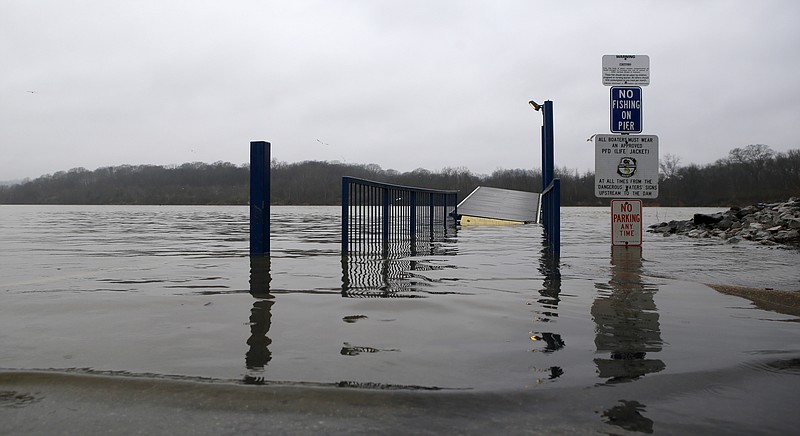Rivers are the water of life, and the Tennessee River is a mighty life giver.
At 652 miles long, she flows from Knoxville through Chattanooga and on to Huntsville, Ala., before turning north to dip into a corner of Mississippi and then straight up to Paducah, Ky., where she spills into the Ohio River and eventually mingles into the Gulf-bound Mighty Mississippi.
But she completely misses Georgia - by a mile and a fluke of historical fate.
That doesn't keep thirsty Atlanta from eyeing this jewel to the north. Nor does that keep Georgia politicians from threatening every few years to make a Tennessee land and water grab.
"I just want to threaten them and then stick a straw into the Tennessee River," Georgia Senate President Pro Tempore Butch Mill, R-Gainesville, said last month.
The problem dates back to the early 1800s when land surveyors using rudimentary tools and the stars set the Tennessee-Georgia border one mile farther south of the 35th parallel mark that Congress had decreed. Now Georgia lawmakers want to move 51 miles of state line and pipe away hundreds of millions of gallons of water a day from the natural watershed basin that geology - not mapmakers - made for the Tennessee River.
The patch of land that Georgia's Legislature says it will settle for without a lawsuit is a grassy stand just across Georgia's northwest border near what we know as Nickajack Cave.
In recent years, nothing much has happened over Georgia's on-again, off-again threats - save the laughter of a few Tennessee lawmakers. But this year, when Tennessee Rep. Marc Gravitt, R-East Ridge, begged for a resolution urging Gov. Bill Haslam not to participate in the Peach State's renewed attempts to negotiate the dispute, the resolution died for lack of a motion - even a lack of discussion - in the House Delayed Bills Committee.
This question isn't just an oddity or a joke. With growing populations and rising temperatures, water is becoming the new gold. Instead of planning how to steal it, we need to plan now to conserve it. And if you're one of those who says Tennessee, as home to the fifth largest river system in the nation, has plenty of water so why not just share, consider the Colorado River story.
The Colorado - still the fourth largest river system in America - once flowed from the Rockies into Mexico and then to the Gulf of California. But now, after being diverted hundreds of miles outside its natural basin to Los Angeles, San Diego and Phoenix, 70 percent of the Colorado's water is siphoned away. What was once a lush delta in Mexico where the river joined the ocean is now arid.
That could easily happen to the Tennessee River if Atlanta and Georgia "stick a straw" into the Tennessee and siphon off the 1.5 billion gallons a day that Georgia lawmakers believe should be theirs. For context, one Georgia consultant recently told the Atlanta Journal-Constitution that the Tennessee has "1 billion gallons per day of excess capacity." Do the math, and remember that plenty more cities downstream of Chattanooga and Nickajack Lake drink water and manufacture and irrigate crops from the Tennessee River.
A river system gets its water from tributary streams that flow downhill to the river in the geographic bowls that form that river's "watershed." The Tennessee drains a nearly 41,000-square-mile watershed area.
Picture a stream in your backyard that starts from a spring two houses up the street from you and ends in a lake two houses down from you. You and your four neighbors are a basin - a watershed.
But the neighbor just upstream from you decides to build a koi pond and divert water from the stream. He lets the excess water from the pond run to his garden. Any trickles left flow into the sewer drain. Suddenly the stream in your yard is much diminished. And by the time it reaches the neighbor's lake on the other side of you - the downstream side - it can no longer keep the lake filled except in times of very heavy rain.
Your upstream neighbor's drain is moving water out of your basin - your watershed - and not returning any leftovers.
Diverting water from the Tennessee at Nickajack Lake and sending it to Atlanta would be like the neighbor's koi pond that overflows to the sewer. The water - even as wastewater, treated or untreated - never comes back to recharge the stream.
Even within its own "basin," the Tennessee River in dozens of ways serves 4.5 million people - an increase in population of about 15 percent just since 1990, according to a U.S. Geological Survey report.
Atlanta is one of the few cities on the continent that was not built on a river or water source that could sustain it. It keeps growing - both in the city limits and out into suburbs, but neither the city nor Georgia is dealing with that growth in any durable way - except to model the Los Angeles/Colorado "straw" method and to threaten the Tennessee River. And it isn't that Georgia doesn't understand what happens downstream. The state has been locked in lawsuits for years with Alabama and Florida over depleting water from other rivers that should be flowing across its state line to those states.
In 2013, the Tennessee American Water Co. said Chattanoogans on average use 95 gallons of water per person per day. In Atlanta, that per-person number is 151 gallons a day - despite Georgia summer watering bans and public appeals for conservation, according to Georgia officials.
The great pity is that we - all of us in any state and on any waterway - haven't quite figured out how to save the billions of gallons of flood waters that just flow away and through our reservoirs when seasonal heavy rains blanket the Southeast.
We need second cups for storage when our first cups runneth over.
